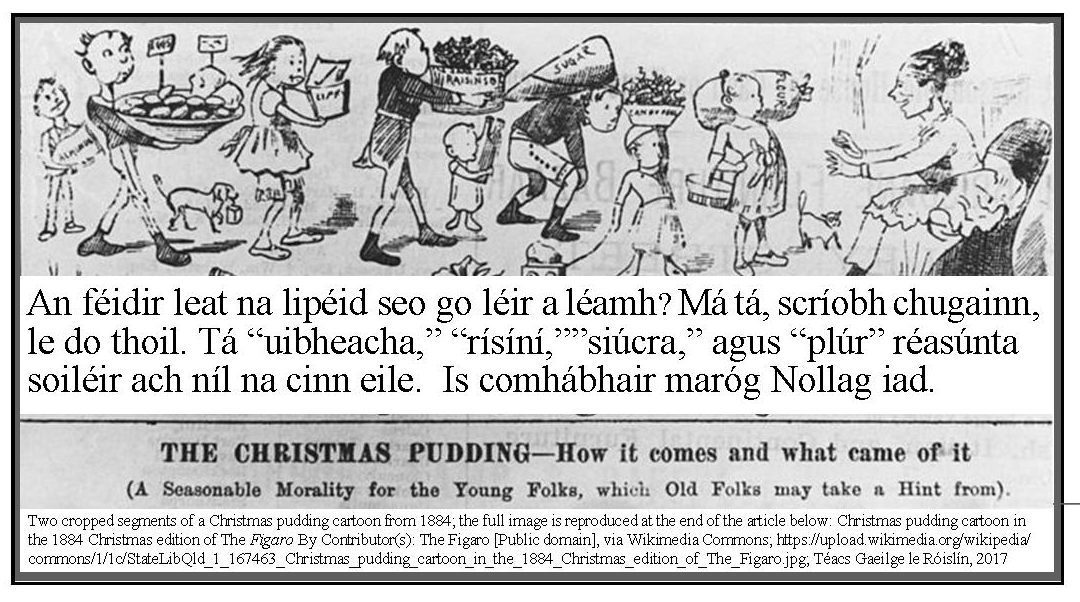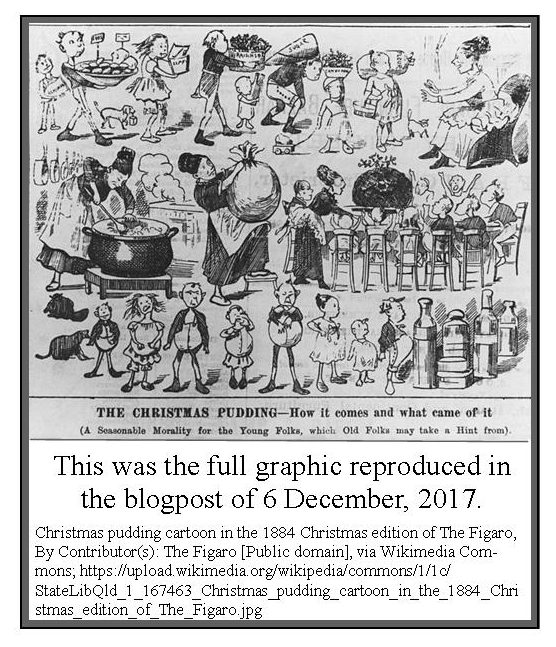Maróg Nollag — Na Comhábhair agus Na Lipéid sa Chartún Thíos (Christmas Pudding, ar leanúint) Posted by róislín on Dec 11, 2017 in Irish Language
(le Róislín)
Ba é “Maróga Nollag” téama na blagmhíre deireanaí (nasc thíos), le seanghraific faoi réiteach na maróige agus na tinnis bhoilg a bhí ar na daoine a d’ith barraíocht di. Tá an léaráid an ghreannmhar.Last time, I mentioned that there were several labels in the illustration that I was not able to read. They were too small (róbheag) and too blurry (ródhoiléir). I also asked that if any reader is able to decipher them (iad a scaoileadh nó iad a oibriú amach), it would be great if they could write in to tell us. To facilitate this (hopefully), I’ve included a cropped portion of the graphic, the part that has the labels (na lipéid), above, and the lettering is now a little larger (beagán níos mó) but still blurry (doiléir fós). For anyone who hasn’t seen it yet, the full graphic is reproduced below.
I thought a cropped and enlarged version might help someone read the words, especially maybe if we have any seasoned Christmas pudding-makers here (déantóirí maróg Nollag a bhfuil seantaithí acu .i. seantaithí acu maróga Nollag a dhéanamh). Perhaps they might be able to anticipate the ingredients just from knowing the typical recipes (na hoidis thipiciúla).
Speaking of déantóirí maróg Nollag, you might like to read the short piece entited “Maróga,” by Sean Ó [sic] i gConnecticut in his blog “Thall agus Abhus.” It’s just a short paragraph but it has a couple of pictures showing a maróg in the works. Agus dála an scéil, ” Dia dhuit a Sheáin — is fada ó chonaic mé thú.” Nasc thíos.
Anyway, it gives us another opportunity to look at the words (na focail) for the ingredients (na comhábhair, lit. the “co-matter”), in Irish, with their various forms. From left to right (ó chlé go deas), we have eggs, raisins, sugar, and flour. From a grammar viewpoint, we have one 1st-declension noun, one 2nd-declension one, and two 4th-declension ones.
Let’s check the declensions out first. Here’s a little dúshlán meaitseála:
Na díochlaontaí: a) an chéad díochlaonadh b) an dara diochlaonadh c) an ceathrú díochlaonadh d) mar “c” .i. 4ú
Na ceithre fhocal: 1) plúr 2) siúcra 3) ubh, iol: uibheacha 4) rísín, iol: rísíní
Freagraí thíos.
And now a bhfoirmeacha. For “uibheacha” (eggs), we have:
an ubh, the egg
na huibhe, of the egg
na huibheacha, the eggs
na n-uibheacha, of the eggs
An chéad cheann soléite eile:
an rísín, the raisin
an rísín, of the raisin (no change)
na rísíní, the raisins
na rísíní, of the raisins (gan athrú).
Piece o’ <errmm> cake, that one is, isn’t it? No special endings and no changes at the beginning. And that’s because it’s in the _________ declension (just to belabor that point; your answer should be the same as in the word-match above!). Freagra don bhearna thios.
An tríú ceann atá soléite:
an siúcra, the sugar
an tsiúcra, of the sugar
The plural is pretty rare, probably about like in English, but in theory, at least, you could put an “í” at the end to make it plural.
Agus faoi dheireadh:
an plúr, the flour, and just to <errmm> mix it up a bit, let’s add the adjective “white” (geal, in this case, not ”bán“), so we have:
an plúr geal, the white flour
an phlúir ghil, of the white flour
This is also not common in the plural (ooh, a near, if nonsensical, pun there — what’s the plural of plúr, if any?), but I don’t see why we couldn’t use it in certain circumstance, like in a recipe that combines two types of flour (plúr geal agus plúr cruithneachta, mar shampla). So let’s at least experiment with it. “Plúir” would presumably be the plural, so a recipe (oideas) might say, “mix the flours together,” which would be “measc na plúir le chéile.”
Of course, if the instructions said to mix the two flours together, we’d be back to square one, no plural ending after the numbers, in almost all cases, and certainly not after “two.” So that would be: Measc an dá phlúr le chéile. When you lose some, though you win some, too — we have to add lenition after “an dá.” Never a dull moment as far as initial consonant mutation goes!
Bhuel, I hope that was fun (spraíúil) and informative (faisnéiseach), and maybe it will inspire someone to make a Christmas pudding, brandy (branda), and cream sauce (anlann uachtair), and blue flames (lasracha gorma) for the flambé style, and all! And remember, if you can interpret those ingredients on the blurry labels, please write in and let us know. Then we can translate them into Irish. — Slán go fóill — Róislín
Nasc don bhlag eile sa tsraith seo: Maróga Nollag (That’s “Christmas Puddings” in Irish): A gComhábhairPosted by róislín on Dec 6, 2017 in Irish Language
Nasc do bhlag Sheáin: http://seano-thallisabhus.blogspot.com/2010/11/maroga.html
Freagraí:
Na díochlaontaí: a) an chéad díochlaonadh b) an dara diochlaonadh c) an ceathrú díochlaonadh d) mar “c” .i. 4ú
Na ceithre fhocal: 1a) plúr 2c) siúcra 3b) ubh, iol: uibheacha 4d) rísín, iol: rísíní
The choices “c” and “d” are, of course, interchangeable (inmhalartaithe).

Build vocabulary, practice pronunciation, and more with Transparent Language Online. Available anytime, anywhere, on any device.






Leave a comment: